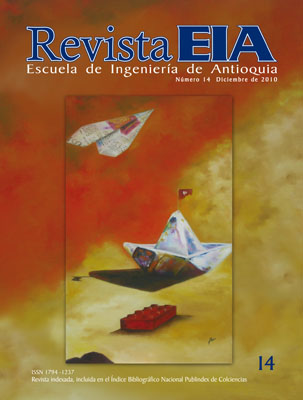ESTUDIO COMPARATIVO DE LA REMOCIÓN DE MATERIA ORGÁNICA EN HUMEDALES CONSTRUIDOS DE FLUJO HORIZONTAL SUBSUPERFICIAL USANDO TRES ESPECIES DE MACRÓFITAS (COMPARATIVE STUDY OF THE ORGANIC MATTER REMOVAL IN HORIZONTAL SUBSURFACE FLOW CONSTRUCTED WETLANDS USI
ESTUDIO COMPARATIVO DE LA REMOCIÓN DE MATERIA ORGÁNICA EN HUMEDALES CONSTRUIDOS DE FLUJO HORIZONTAL SUBSUPERFICIAL USANDO TRES ESPECIES DE MACRÓFITAS (COMPARATIVE STUDY OF THE ORGANIC MATTER REMOVAL IN HORIZONTAL SUBSURFACE FLOW CONSTRUCTED WETLANDS USI


This work is licensed under a Creative Commons Attribution-NonCommercial-NoDerivatives 4.0 International License.
Copyright statement
The authors exclusively assign to the Universidad EIA, with the power to assign to third parties, all the exploitation rights that derive from the works that are accepted for publication in the Revista EIA, as well as in any product derived from it and, in in particular, those of reproduction, distribution, public communication (including interactive making available) and transformation (including adaptation, modification and, where appropriate, translation), for all types of exploitation (by way of example and not limitation : in paper, electronic, online, computer or audiovisual format, as well as in any other format, even for promotional or advertising purposes and / or for the production of derivative products), for a worldwide territorial scope and for the entire duration of the rights provided for in the current published text of the Intellectual Property Law. This assignment will be made by the authors without the right to any type of remuneration or compensation.
Consequently, the author may not publish or disseminate the works that are selected for publication in the Revista EIA, neither totally nor partially, nor authorize their publication to third parties, without the prior express authorization, requested and granted in writing, from the Univeridad EIA.
Show authors biography
Los humedales construidos se presentan actualmente como una tecnología prometedora en reducir la contaminación por aguas residuales; este estudio investigó la remoción de materia orgánica con agua residual sintética, en términos de demanda química de oxígeno (DQO), demanda biológica de oxígeno (DBO5) y mediciones in situ de pH, oxígeno y temperatura cada 15 días, durante 3 meses, en seis sistemas de humedales construidos de flujo subsuperficial horizontal, a escala piloto, sembrados con tres diferentes macrófitas: Canna limbata, Heliconia psittacorum y Phragmites sp; las remociones medias de DQO fueron de 97,31 % y 95,94 % para Cannalimbata; 94,49 % y 93,50 % para Heliconia psittacorum; 97,39 % y 97,13 % para Phragmites sp. En DBO5 fueron de 100 % y 99,36 % para Canna limbata; 99,09 % y 97,49 % para Heliconia psittacorum; 100 % y 99,45 % para Phragmites sp. Se concluye que existen diferencias significativas para la remoción de DQO entre las diferentes plantas (P < 0,05); en la remoción de la DBO5 no existen estadísticamente diferencias significativas entre las diferentes plantas (P < 0,05). Este estudio demuestra la opción de reducir la contaminación por materia orgánica utilizando humedales construidos.
Abstract: Constructed wetlands appear at the present time like a promising technology in reducing the pollution by waste waters; this study investigated the organic matter removal with synthetic waste water, in terms of chemical oxygen demand (COD), biological oxygen demand (BOD5) and in situ measurements of pH, oxygen and temperature every 15 days, during three months, in six horizontal subsurface-flow constructed wetland systems, in pilot scale, seeded with three different macrophytes: Canna limbata, Heliconia psittacorum and Phragmites sp; the average removals of COD were of 97,31 % and 95,94 % for Canna limbata; 94,49 % and 93,50 % for Heliconia psittacorum; 97,39 % and 97,13 % for Phragmites sp. In BOD they were of 100 % and 99,36 % for Canna limbata; 99,09 % and 97,49 % for Heliconia psittacorum; 100 % and 99,45 % for Phragmites sp. We conclude that there are significant differences in DQO removal between different plants (P < 0,05); in BOD5 removal significant differences between the different plants do not exist statistically (P < 0,05). This study demonstrates the option to reduce the polution from organic matter using constructed wetlands.
Article visits 872 | PDF visits 376
